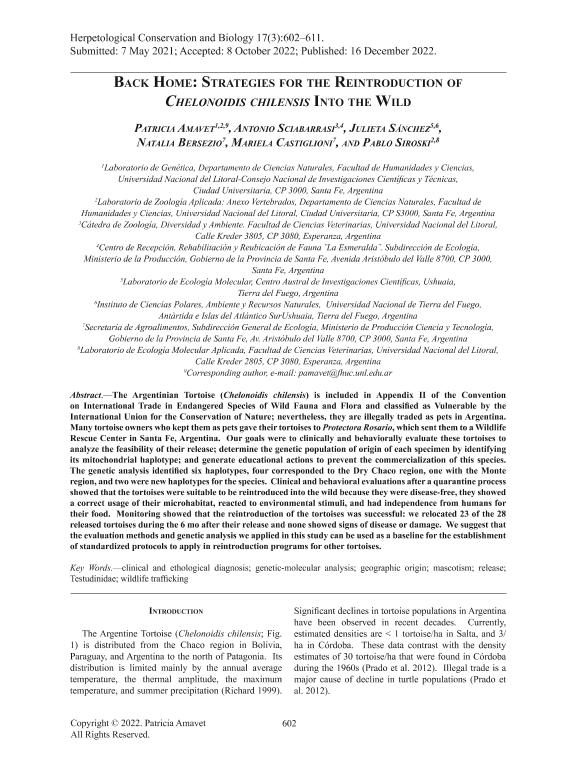Mostrar el registro sencillo del ítem
dc.contributor.author
Amavet, Patricia Susana

dc.contributor.author
Sciabarrasi Bagilet, Antonio Alejandro

dc.contributor.author
Sánchez, Julieta

dc.contributor.author
Bersezio, Natalia Soledad

dc.contributor.author
Castiglioni, Mariela
dc.contributor.author
Siroski, Pablo Ariel

dc.date.available
2023-10-09T20:26:25Z
dc.date.issued
2022-12
dc.identifier.citation
Amavet, Patricia Susana; Sciabarrasi Bagilet, Antonio Alejandro; Sánchez, Julieta; Bersezio, Natalia Soledad; Castiglioni, Mariela; et al.; Back Home: Strategies for the Reintroduction of Chelonoidis chilensis Into the Wild; Herpetological Conservation and Biology; Herpetological Conservation and Biology; 17; 3; 12-2022; 602-611
dc.identifier.uri
http://hdl.handle.net/11336/214653
dc.description.abstract
The Argentinian Tortoise (Chelonoidis chilensis) is included in Appendix II of the Convention on International Trade in Endangered Species of Wild Fauna and Flora and classified as Vulnerable by the International Union for the Conservation of Nature; nevertheless, they are illegally traded as pets in Argentina. Many tortoise owners who kept them as pets gave their tortoises to Protectora Rosario, which sent them to a Wildlife Rescue Center in Santa Fe, Argentina. Our goals were to clinically and behaviorally evaluate these tortoises to analyze the feasibility of their release; determine the genetic population of origin of each specimen by identifying its mitochondrial haplotype; and generate educational actions to prevent the commercialization of this species. The genetic analysis identified six haplotypes, four corresponded to the Dry Chaco region, one with the Monte region, and two were new haplotypes for the species. Clinical and behavioral evaluations after a quarantine process showed that the tortoises were suitable to be reintroduced into the wild because they were disease-free, they showed a correct usage of their microhabitat, reacted to environmental stimuli, and had independence from humans for their food. Monitoring showed that the reintroduction of the tortoises was successful: we relocated 23 of the 28 released tortoises during the 6 mo after their release and none showed signs of disease or damage. We suggest that the evaluation methods and genetic analysis we applied in this study can be used as a baseline for the establishment of standardized protocols to apply in reintroduction programs for other tortoises.
dc.format
application/pdf
dc.language.iso
eng
dc.publisher
Herpetological Conservation and Biology
dc.rights
info:eu-repo/semantics/openAccess
dc.rights.uri
https://creativecommons.org/licenses/by-nc-sa/2.5/ar/
dc.subject
Clinical and ethological diagnosis
dc.subject
Genetic-molecular analysis
dc.subject
Geographic origin
dc.subject
Mascotism
dc.subject
Release
dc.subject
Testudinidae
dc.subject
Wildlife trafficking
dc.subject.classification
Zoología, Ornitología, Entomología, Etología

dc.subject.classification
Ciencias Biológicas

dc.subject.classification
CIENCIAS NATURALES Y EXACTAS

dc.title
Back Home: Strategies for the Reintroduction of Chelonoidis chilensis Into the Wild
dc.type
info:eu-repo/semantics/article
dc.type
info:ar-repo/semantics/artículo
dc.type
info:eu-repo/semantics/publishedVersion
dc.date.updated
2023-06-30T15:19:40Z
dc.identifier.eissn
1931-7603
dc.journal.volume
17
dc.journal.number
3
dc.journal.pagination
602-611
dc.journal.pais
Estados Unidos

dc.journal.ciudad
Oregon
dc.description.fil
Fil: Amavet, Patricia Susana. Consejo Nacional de Investigaciones Científicas y Técnicas. Centro Científico Tecnológico Conicet - Santa Fe; Argentina. Universidad Nacional del Litoral. Facultad de Humanidades y Ciencias. Departamento de Ciencias Naturales. Laboratorio de Zoología Aplicada: Anexo Vertebrados (FHUC-UNL/MASPyMA); Argentina. Universidad Nacional del Litoral. Facultad de Humanidades y Ciencias. Departamento de Ciencias Naturales; Argentina
dc.description.fil
Fil: Sciabarrasi Bagilet, Antonio Alejandro. Universidad Nacional del Litoral. Facultad de Ciencias Veterinarias; Argentina. Gobierno de la Provincia de Santa Fe. Ministerio de Ambiente.; Argentina
dc.description.fil
Fil: Sánchez, Julieta. Consejo Nacional de Investigaciones Científicas y Técnicas. Centro Austral de Investigaciones Científicas; Argentina. Universidad Nacional de Tierra del Fuego, Antártida e Islas del Atlántico Sur. Instituto de Ciencias Polares, Ambientales y Recursos Naturales; Argentina
dc.description.fil
Fil: Bersezio, Natalia Soledad. Gobierno de la Provincia de Santa Fe. Ministerio de Ambiente.; Argentina
dc.description.fil
Fil: Castiglioni, Mariela. Gobierno de la Provincia de Santa Fe. Ministerio de Ambiente.; Argentina
dc.description.fil
Fil: Siroski, Pablo Ariel. Consejo Nacional de Investigaciones Científicas y Técnicas. Centro Científico Tecnológico Conicet - Santa Fe. Instituto de Ciencias Veterinarias del Litoral. Universidad Nacional del Litoral. Facultad de Ciencias Veterinarias. Instituto de Ciencias Veterinarias del Litoral; Argentina. Universidad Nacional del Litoral. Facultad de Humanidades y Ciencias. Departamento de Ciencias Naturales. Laboratorio de Zoología Aplicada: Anexo Vertebrados (FHUC-UNL/MASPyMA); Argentina
dc.journal.title
Herpetological Conservation and Biology
dc.relation.alternativeid
info:eu-repo/semantics/altIdentifier/url/https://www.herpconbio.org/Volume_17/Issue_3/Amavet_etal_2022.pdf
Archivos asociados
